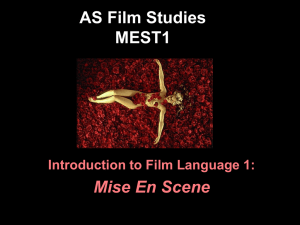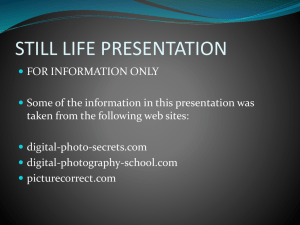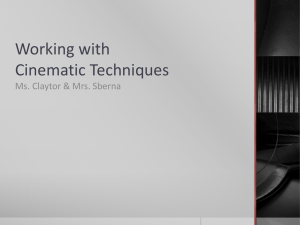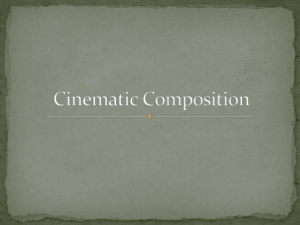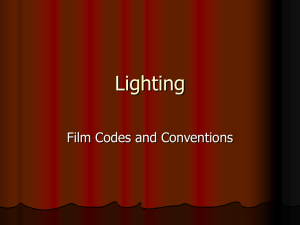File - Ms.Zaborowski
advertisement
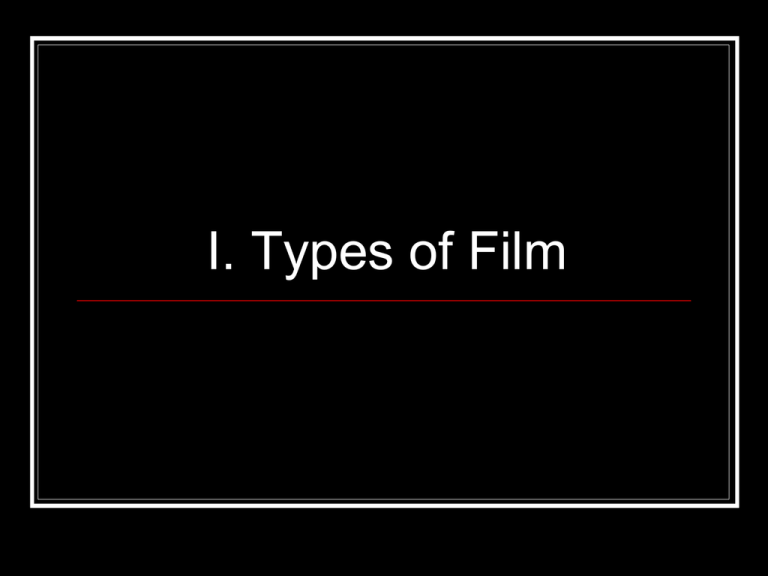
I. Types of Film (STYLES) Realism -- Classicism --- Formalism -------------------------------------------------Documentaries – Fiction -- Avant-Garde (TYPES) A. Objective Camera • Camera views scene as a remote spectator. • Viewer forgets the camera is there. • Realistic B. Subjective Camera • Camera views a scene from the visual or emotional point of view of a character. • The camera draws attention to itself. • Manipulates meaning • Formalistic Subjective vs. Objective Camera Vertigo D: Alfred Hitchcock, 1958 C. Realism in Film • Camera is an unmanipulated, objective mirror of the real world. • • • • Everyday, realistic images Basic experiences of everyday life Loosely organized story Emphasis on authenticity Realism (cont.) • Long, uninterrupted shots • Minimal editing • Natural lighting 1. “Arrival of a Train” (Realism) • • • • Lumieres brothers, 1896 Founders of cinematic realism. Considered fascinating and terrifying. A “actualités” (primitive documentary). Arrival of a Train 2. “The Kiss” (Realism) • Directed for Thomas Edison, 1896 • A 47 second long actuality; one of the first films made available to the public. • Considered scandalous and “disgusting.” The Kiss 3. Hearts and Minds (Realism) • Davis, 1974 • • Primarily TV newsreel footage of Vietnam Indictment of the US devastation of • Vietnam Turned public opinion against the war. Hearts and Minds (Prostitution) D. Classicism • • • Story-oriented; based on entertainment value Avoids extremes The images chosen for their relevancy to the story and characters, rather than for their authenticity (realism) or formal beauty alone (formalism). Classicism (cont.) • Hollywood stars • Controlled lighting and sets • Moderate editing • Generally visually appealing and highly romanticized 1. Gone With the Wind • Victor Fleming, 1939 • Epic Romance, Classic Hollywood Film Gone With the Wind 2. The Royal Tenenbaums • • Wes Anderson, 2001 Manipulation of the camera to better tell a story - cuts, reaction shots, slow motion, music, etc. The Royal Tenenbaums E. Expressionism/Formalism • In-your-face; high degree of manipulation and editing • • Stylized visuals (special effects) Emphasis on technique and expression • rather than story. Manipulation of color and lighting Expressionism/Formalism (cont.) • Filmmakers concerned with spiritual and psychological truths • Characters and events often extraordinary and symbolic • Often artificial genres: musicals, scifi, fantasy,etc. 1. A Trip to the Moon • • • • Georges Melies, 1902 First science fiction film (silent) Innovative use of special effects and animation Whimsical fantasy based on purely imagined events. A Trip to the Moon (3:00) Conquest of the North Pole (5:00) 2. Pi • • • • • Pi Darren Aronofsky, 1998 Psychological, surrealistic Distorted imagery High level of manipulation (editing, sound, lighting) Emotive, dream-like, paranoid, and troubling 3. Raging Bull • • • • Martin Scorsese, 1980 Subjective camera Fair level of manipulation Plays with color, time, and camera angles to create a visual story Raging Bull (Start 1:00) II. Mise en Scene / Intro to Cinematography A. Cinematography: The making of lighting and camera choices when recording photographic images for the cinema. Closely related to the art of still photography. B. Mise en Scene How visual elements are staged, framed and photographed. French for “placing on a stage.” Involves: size, color, light, objects’ relationship to one another 1.The Dominant Where is our eye attracted first? Why? The dominant can be created by: * the size of an object, * a juxtaposition of lights and darks (esp. in black and white films), * using a color that stands out from the others, * placing one object in sharper focus than the rest of the shot. The dominant in this shot is the character of Enid (Thora Birch). This is created by color, lighting and focus. 2. Positioning of Characters & Objects within a frame Positioning within a frame can draw our attention to an important character/object A film-maker can use positioning to indicate relationships between people. IMAGE 1 3. Color Carries certain connotations which may add meaning (i.e. Red = Danger/Passion) Can give a scene a particular look, feel or mood Can be used for dramatic effect Cool tones (left) are associated with sadness and strife. Warm tones (right) are romantic and happier. How is color affecting the mise en scene of this shot? 4. Lighting Lighting can be used to achieve a variety of effects: Highlight important characters or objects within the frame Make characters look mysterious by shading sections of the face & body To reflect a character’s mental state/hidden emotions (i.e. bright = happy, dark = disturbed, strobe effect = confused 1. Low Key Lighting • Produces an overall darker picture. • Emphasizes diffused shadows and atmospheric pools of light. • Often used in mysteries and thrillers. Tends to heighten the sense of alienation • felt by the viewer, hence is commonly used in film noir, horror, mysteries and thrillers. Low-Key Film Still: The Shining Watch: Raging Bull (Scorsese) Barton Fink (Coens) 2. Film Noir Term used to describe stylish, Hollywood crime dramas, popularized in the 1940-50s. French for “black film.” Lighting is low key, very high contrast, and tends to be black and white. Settings tend to be urban; swirling cigarette smoke adds an air of mystery. Tone is fantastic and paranoid. Focuses on the dark side of humanity (violence, lust, greed, etc) Film Noir Still: High Contrast Watch: Double Indemnity (Wilder) Batman (Burton) 3. High Key Lighting • • Bright, even illumination, with few conspicuous shadows. Generally used in upbeat scenes, hence used mostly in comedies, musicals and light entertainment films. Watch: Some Like It Hot (Wilder) Austin Powers (Roach) What types of lighting are used in the following images: B A D E C F
